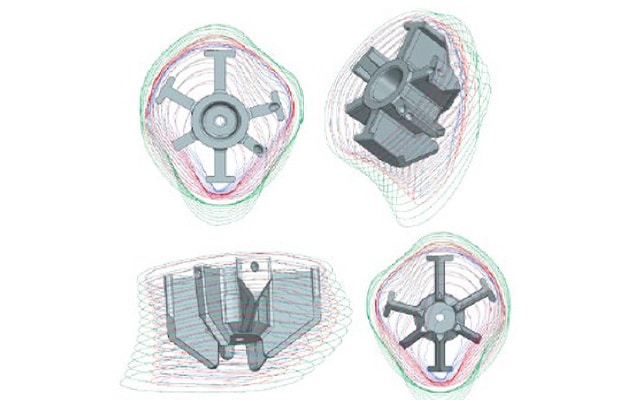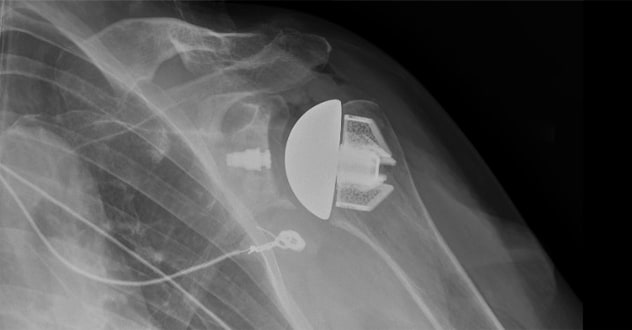July 25, 2025
 تصميمات غرسات الكتف غير المتماثلة للكتفين الأيمن والأيسر
تصميمات غرسات الكتف غير المتماثلة للكتفين الأيمن والأيسر
توفر تصميمات غرسات الكتف غير المتماثلة والمخصصة للكتف الأيمن والأيسر ملاءمة مثالية، وتُحسِّن الثبات، وتصل إلى العظم الإسفنجي الكثيف المحيطي.
A Mayo Clinic orthopedic surgeon and team have placed the world's first next-generation, right- and left-specific stemless shoulder implant. This is part of a larger trend toward more-anatomic total shoulder arthroplasty, according John W. Sperling, M.D., an orthopedic surgeon at Mayo Clinic in Minnesota.
"Anatomic shoulder arthroplasty gives patients more-normal, natural motion, especially the ability to reach a hand behind their backs compared to reverse arthroplasty," says Dr. Sperling.
"Though it may sound mundane, this helps facilitate range of motion to scratch an itch, pull a necktie around the neck or fasten a button in the back of a top."
New shoulder implants versus the former stemless shoulder implants
"Now we have recognized that the proximal bone is inherently asymmetric, and these anatomically shaped shoulder implants match the patient's bone."
The new stemless implants are asymmetric, thus distinct from traditional, symmetric stemless implants. The implants were modeled to match a patient's native anatomy, which means they are not perfectly circular.
"Right and left shoulders are naturally different," Dr. Sperling says. "The shape of the new stemless implants reflects that the humeral shape is side-specific as well as the proximal humerus is heart-shaped, not circular."
The advent of the right- and left-specific implants is especially important due to better fit and fixation into the best quality bone, says Dr. Sperling.
"What we've done forever with shoulder replacements is force a symmetric implant into an asymmetric bone," he says. "We were essentially pushing a puzzle piece into a place it didn't fit. Now we have recognized that the proximal bone is inherently asymmetric, and these anatomically shaped implants match the patient's bone."
Additional advantages of the new implants
Other advantages of the right- and left-specific stemless shoulder implants include:
- Bone preservation. These new implants allow the surgeon to preserve more of the patient's own bone. Bone removal is minimized.
- Decreased blood loss and pain. These benefits derive from not needing to drill down the canal as far as a traditional, stemmed shoulder implant requires. Some surgeons also have noted decreased pain with stemless compared with stemmed implants by not violating the humeral canal.
- Optimized fixation and stability. These implants not only engage the best-quality bone, the peripheral dense cancellous bone, but also improve fixation. This is due to better anatomic suitability at the point of application, yielding increased fixation strength equivalent to using a stemmed implant.
- Shortened surgical length. There is less instrumentation needed for stemless compared with stemmed implants, resulting in less time to complete the procedure.
- Broadened eligibility for stemless implants. Right- and left-specific implants, which are built as stemless implants, improve fixation strength compared with prior symmetric designs, opening the possibility of using stemless implants on a wider pool of patients.
- Easier revision, if needed. If a patient with a right- or left-specific stemless shoulder implant needs a revision in the future, a surgeon could perform it efficiently due to the bone preservation of the original procedure.
- Soft tissue optimization. As these implants are stemless and placed in the natural center of the humeral bone, they help optimize the soft tissue tension of the construct.
 أشعة سينية بعد العملية
أشعة سينية بعد العملية
مثال على صورة أشعة سينية بعد العملية تُظهر غرسة غير متماثلة بدون جذع مع تثبيت حقاني هجين.
"There is increasing interest in anatomic shoulder arthroplasty compared to reverse arthroplasty due to more natural motion," says Dr. Sperling. "Also, with improved socket fixation, loosening of the shoulder implant has decreased and its lifespan improves dramatically, as demonstrated in a publication in Journal of Shoulder and Elbow Surgery: Reviews, Reports and Techniques."
If the patient requires two replacements, the surgeon performs the next-generation implants one at a time and not simultaneously.
Dr. Sperling says that the original surgery to place a next-generation shoulder implant went extremely well. Now, Mayo Clinic has completed more than 50 of these next-generation shoulder implants.
For more information
Marigi EM, et. al. Hybrid fixation in anatomic shoulder arthroplasty: Surgical technique and review of the literature. Journal of Shoulder and Elbow Surgery: Reviews, Reports and Techniques. 2021;1:113.
Refer a patient to Mayo Clinic.